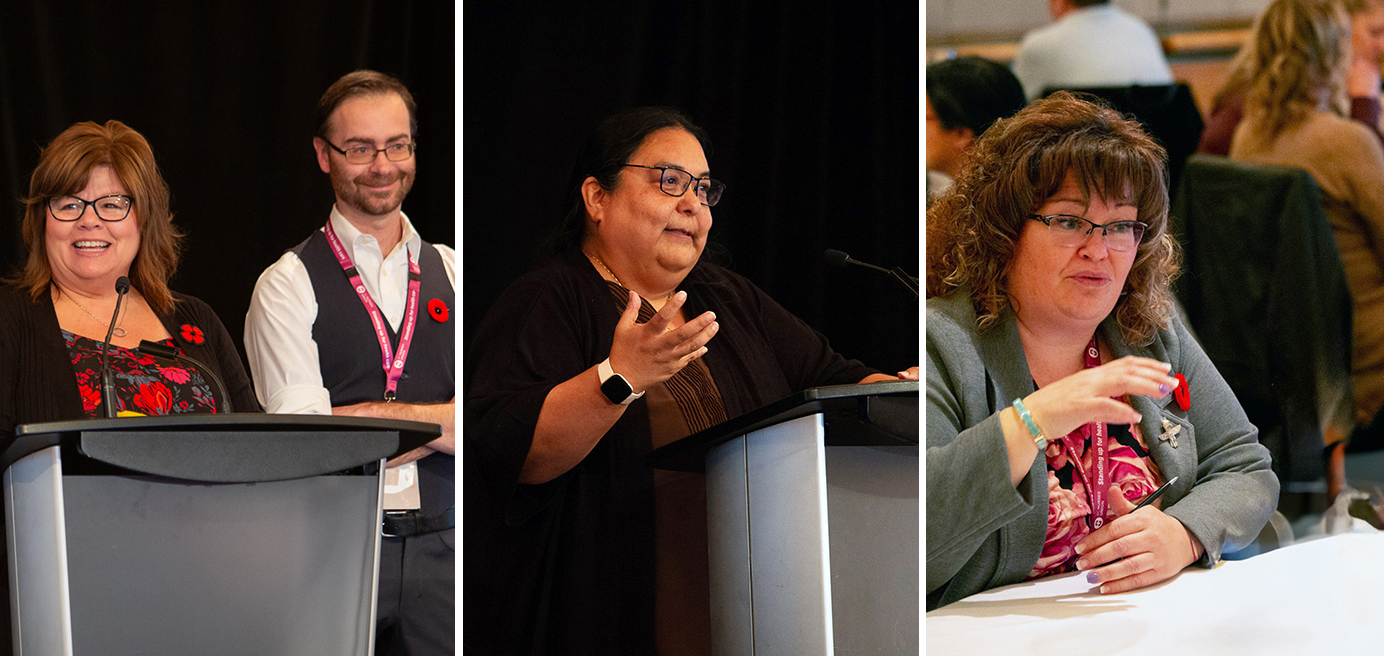 Professional Practice Conference: Building a Strong Foundation
Professional Practice Conference: Building a Strong Foundation

More than 150 BCNU members from around the province gathered in Vancouver on Nov.1 for the union’s annual professional practice conference. Enhancing Nursing Practice: Building a Strong Foundation was this year’s theme, which explored a wide range of issues relevant to today’s nursing profession.
Addressing the Shortage: Nurse-Patient Ratios
The day kicked off with a panel discussion on minimum nurse-patient ratios moderated by BCNU’s director of professional practice and advocacy, Mycal Barrowclough.
BC will become the first province in Canada to implement minimum nurse-patient ratios for its critically understaffed nursing workforce. Since the April 2023 agreement between the Nurses’ Bargaining Association (NBA) and the Ministry of Health to support nursing in the province, BCNU staff and senior elected leaders have been participating in working groups and on a provincial executive steering committee tasked with introducing the new staffing model.
BCNU’s interim chief executive officer and chief negotiator Jim Gould reminded conference attendees that BCNU has been advocating for minimum nurse-patient ratios for over 25 years. BCNU President Adriane Gear followed Gould, agreeing that the momentum behind minimum nurse-patient ratios is growing. Gear is optimistic about the relationship between BCNU, the health ministry and health employers but is under no illusion that every meeting is also a negotiation on what implementation will look like at health-care worksites in BC.
“Holding the government accountable to the promise of minimum nurse-patient ratios is our top priority,” she said.
BCNU Vice President Tristan Newby then told attendees that direct care nurse engagement will be critical in the planning and introduction of minimum nurse-patient ratios in the province. He encouraged members to submit expressions of interest to become more involved in the initiative, and warned that an active membership is critical to prevent managers from sabotaging the implementation process.
“Once the wheels are in motion, nurses are the ones making ratios work,” he said.
Exploring Moral Distress
The presentation, Exploring Moral Distress, hit close to home for many of the nurses attending this year’s conference. Presenters and somatic educators Angelica Singh and Anita Chari teach embodied and trauma-informed practices to health-care workers. They explained what some of the symptoms of moral trauma, moral injury and compassion fatigue look like and why it’s important nurses practice self-care, set boundaries and support each other in times of crisis.
“Compassion fatigue sets in when we think that if we can just meet this person’s needs then my needs will be met,” said Chari. “Setting boundaries is key to managing expectations.”
The discussion prompted some attendees to share their personal stories with the room, explaining how the province’s staffing crisis and difficult working conditions have led them to feel depressed, anxious and exhausted.
Cultural Safety and Humility
Creating culturally safe, culturally aware, and anti-racist health-care settings was the theme of an in-depth afternoon panel discussion, made up of three people who have made it their life’s work to help nurses successfully apply these principles in practice.
Tania Dick, an Indigenous nurse and Director for Cultural Safety and Humility and Clinical Practice with the BC Ministry of Health’s Indigenous Health and Reconciliation division, gave a passionate account of her experiences with racism throughout her career.
Paula Foster, a regulatory practice consultant with the BC College of Nurses and Midwives (BCCNM), provided conference attendees with an overview of why it is critical that patients and nurses feel culturally safe.
“We all deserve the right to culturally safe care,” she stated during her remarks.
BCNU Director of Diversity, Equity and Inclusion hanif karim wrapped up the discussion by thanking the many individuals behind the new language on cultural safely contained in the recently bargained NBA collective agreement.
Walking Together: Indigenous Allyship in Action
Len Pierre’s presentation, Walking Together: Indigenous Allyship in Action, challenged attendees to think critically about how they approach allyship with Indigenous peoples. Pierre, a professor of Indigenous studies at Kwantlen Polytechnic University in Surrey, emphasized the importance of following Indigenous leadership and doing more listening than talking. Acting in solidarity with Indigenous people in this way consistently over time, he said, will build trust and relationships. By always asking how we can help and showing “servant leadership,” Pierre believes we can help combat racism and create an environment of cultural safety in our health-care system and beyond.
Gear wrapped up the day and thanked conference participants for attending. She acknowledged that working conditions are more challenging than ever—many nurses are experiencing burnout as a result of staff being stretched thin. She left attendees with a commitment on behalf of BCNU’s leadership to continue advocating for the profession and addressing the workplace issues nurses face every day.
Visit BCNU's Facebook page to view photos from the event.
Look for a full report on the conference in the Fall/Winter online edition Update Magazine.

